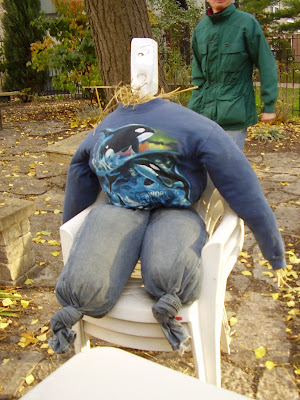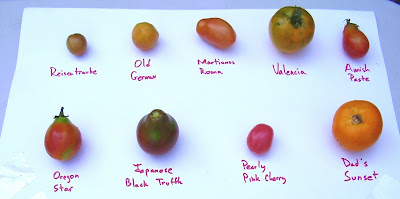Strangely, Nature gave us an abnormally cool and wet October, and a mild November. Put together, that made one of the most autumnal falls seen around these parts for a while, and we enjoyed the chance to wind down the gardening year a little more slowly.
Here's our catch-all, two-months-in-pictures, end-of-season posting.
Saturday October 10 saw us harvesting sweet potatoes (who said you couldn't grow them in Chicago?)...

...picking baby zucchini, baby pattypan and squash flowers (try them lightly sauteed)...

...and getting one final use out of our year-old straw bales (into the compost bins).

This was also the point at which we pulled up most of our tomato beds, resulting in three large buckets full of green tomatoes. More on ripening those in a later post, we hope.
On October 17, we were joined by high-school students from a program at the Notebaert Nature Museum, who helped us clear beds, sow cover crop and make Halloween scarecrows.

A week later, Saturday, October 24, we hosted a large group of enthusiastic volunteers who were finishing up a leadership training program with the Chicago Conservation Corps. Despite the chilly, damp weather, they stayed around and asked lots of questions about the garden and how it is organized.

We did manage a good range of produce in our last harvests, from raspberries...

...to mushrooms...

...to daikon radish and greens.

Even so, the harvest had gotten small enough that we no longer needed to transport it to Vital Bridges by car. Instead, it could all be handled by one man, a bike and a backpack.


Beyond the garden gate the abundance of summer was fading just as clearly. So we found Ginkgo besieged by flocks of sparrows and pigeons attracted by the cover crop seeds and the bales of straw.
Halloween fell on a Saturday this year, so we visited in the morning to work the beds, and then again in the afternoon to set up our scarecrows and treats for the Buena Park Neighbors trick or treat event.
Thanks to everyone who baked or helped organize, especially Stephanie (whose mini-cupcakes were a big hit) and the folks from DePaul (yummy cookies) who kept a stream of pre-schoolers enchanted all evening.




In November, most of our time was spent tidying up the garden to put it in good shape for the spring.
Those jack-o-lanterns we had set out for Halloween looked scarier, if anything, by the following week.

Saturday, November 14 took us over to Garfield Park Conservatory for the Mayor's Landscape Awards (more on that in a separate posting).
And Saturday November 21 was a gloriously crisp and sunny fall day, with time to clean, empty and tidy everything away for the year, and some left over to appreciate the verdant cover crop...

...bursting milkweed pods...

...and a late cosmos bloom.


































